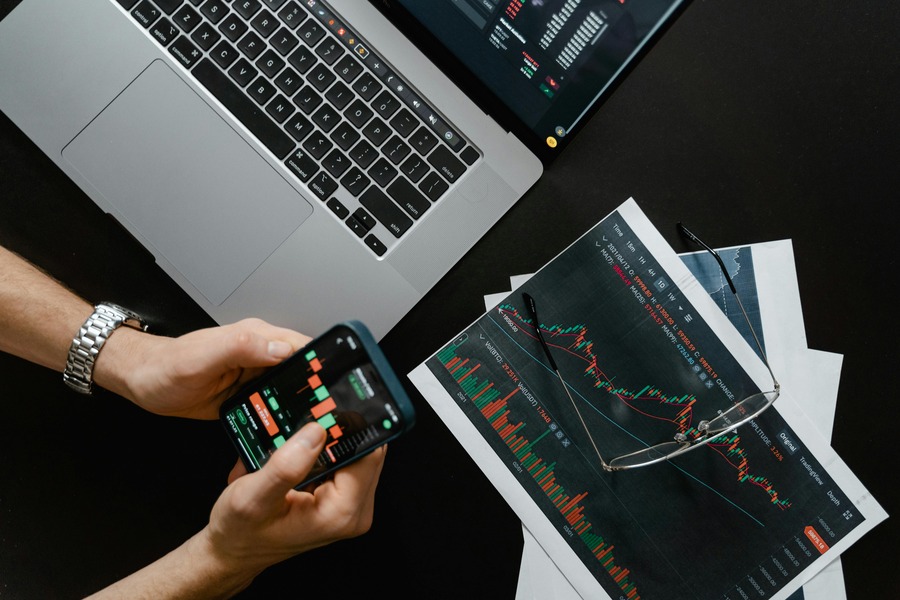The Importance of DYOR (Do Your Own Research)
- 28 Aug 2024

In the rapidly evolving world of cryptocurrency, the phrase "Do Your Own Research" (DYOR) is more than just a buzzword; it's a critical practice that every investor should embrace. As the crypto market continues to attract new participants, understanding why DYOR is essential can help you navigate this volatile market and avoid costly mistakes.
Why DYOR is Crucial in Cryptocurrency
The decentralized nature of cryptocurrency means that there is no central authority overseeing the market. This lack of regulation offers innovation and freedom but also opens the door to risks such as scams, misinformation, and high volatility. Unlike traditional markets where financial institutions and analysts provide guidance, the responsibility in crypto largely falls on individual investors to educate themselves.
Avoiding Scams and Misinformation
The crypto space is rife with scams, ranging from fraudulent Initial Coin Offerings (ICOs) to Ponzi schemes. Scammers prey on fear of missing out (FOMO), luring investors into fake projects with promises of high returns. DYOR allows investors to:
- Verify a project's legitimacy.
- Understand the underlying technology.
- Assess the credibility of the team behind it.
By cross-referencing information and analyzing on-chain metrics, you can identify red flags and avoid falling victim to fraud. To deepen your understanding and learn actionable strategies to protect yourself, check out our comprehensive guide on How to Avoid Crypto Scams.
How DYOR Prevents These Scams
- Cross-Check Partnerships: Verify claimed collaborations with announcements from both parties involved. Fake partnerships are a common red flag.
- Review Tokenomics: Unsustainable tokenomics, such as unlimited supply with no utility, often indicate short-term projects designed to profit developers rather than investors.
- Evaluate On-Chain Data: Tools like Etherscan, Nansen, and Glassnode allow you to analyze wallet activity and identify manipulation or suspicious movements.
- Research the Team: Avoid anonymous teams unless they have a proven track record or are backed by credible organizations.
Example: In 2021, the "Squid Game" token scam tricked investors into buying a token with no utility, draining millions before the creators vanished. Proper research could have revealed discrepancies, such as an anonymous team and no verifiable partnerships. Learn more about this incident in our detailed post on The Squid Game Crypto Scam.

Making Informed Investment Decisions
Investing in cryptocurrency goes far beyond chasing the hottest coin or following market hype. Successful investing requires a deep understanding of key elements that influence a project's potential and its alignment with your financial goals. Here’s what to consider:
- Market Dynamics: Analyze what drives price movements, including demand, supply, market sentiment, and macroeconomic trends. Understanding cycles (bull vs. bear markets) and the factors influencing them helps you time your investments wisely.
- Tokenomics: Assess whether the project has a sustainable economic model. Examine the token supply (fixed or inflationary), distribution, and the real utility of the token within its ecosystem. Projects with poorly thought-out tokenomics are often unsustainable.
- Technology and Use Case: Look beyond flashy promises and evaluate the technology. Is the project solving a genuine real-world problem? Does it have a clear use case that differentiates it from competitors?
- Roadmap and Development: Review the project’s roadmap for realistic milestones and active development. Consistent progress and updates often indicate a committed team and a thriving project.
Thorough research ensures that your investments align with your risk tolerance, financial objectives, and time horizon. By focusing on well-researched decisions, you’ll be better positioned to navigate the volatile crypto market strategically rather than relying on speculation. Remember, an informed investor is a confident investor.
Key Strategies for Conducting DYOR
DYOR involves a systematic approach to gathering and analyzing information. Below are the core steps to conducting effective research:
1. Dive into the Project’s Whitepaper
A whitepaper is the cornerstone of any cryptocurrency project, laying out its purpose, technology, and vision for the future. For investors, it serves as a crucial resource to evaluate the project's credibility and potential.
Key Elements of a Strong Whitepaper
A well-crafted whitepaper should clearly articulate the following:
- The Problem and Solution: What real-world issue is the project addressing, and how does it aim to solve it? Projects that identify genuine challenges are more likely to succeed than those inventing problems for the sake of launching a token.
- Technology Overview: Details about the underlying blockchain, consensus mechanism, scalability solutions, and security features should be provided. A strong technical foundation is essential for long-term sustainability.
- Tokenomics: This includes the total token supply, distribution model, and the token’s utility. For example, tokens with a fixed supply might have long-term scarcity value, while tokens with clear use cases like staking or governance roles demonstrate strong ecosystem integration.
- Roadmap and Milestones: A timeline of planned features, partnerships, and development phases indicates the project’s direction. A well-defined and realistic roadmap reflects careful planning and commitment.
Identifying Red Flags
While reviewing a whitepaper, watch for signs of potential issues:
- Vague or Overhyped Promises: Phrases like "revolutionary" or "game-changing" without substantive technical details often signal weak foundations.
- Lack of Token Utility: If the token serves no real purpose within the ecosystem, it might be a mere fundraising mechanism with little long-term value.
- Unrealistic Timelines: Overly ambitious goals with no clear execution plan can point to a lack of feasibility.
Pro Tip
Always validate the claims made in the whitepaper by cross-referencing with external resources such as GitHub repositories, community forums, or independent analyses. A credible project will have its technical details and promises backed by actionable evidence.
2. Investigate the Team Behind the Project
The team behind a cryptocurrency project is a critical factor in determining its success. A skilled, transparent, and experienced team inspires confidence and sets the foundation for long-term viability.
Evaluating Team Credentials
Start by researching the professional backgrounds of key members, including founders, developers, and advisors:
- Experience in Relevant Fields: Look for expertise in blockchain development, software engineering, or the specific industry the project targets.
- Track Record: Investigate the team’s previous successful ventures or contributions to well-known blockchain projects. LinkedIn profiles and GitHub repositories are excellent resources for verifying claims.
Transparency and Communication
A trustworthy team maintains open lines of communication and regularly updates the community. Look for:
- Regular Updates: Teams that consistently share progress through official blogs, newsletters, or social media channels demonstrate accountability.
- Community Engagement: Participation in forums like Discord, Telegram, or Reddit indicates a commitment to fostering a supportive community. Pay attention to the quality of interactions—constructive and professional communication is a good sign.
Red Flags to Watch
While a transparent and skilled team builds trust, some warning signs should not be ignored:
- Anonymous Founders: While anonymity can sometimes be justified, it often raises accountability concerns. Legitimate projects typically showcase detailed bios of their team members.
- Unverifiable Credentials: Claims of prestigious qualifications or experience should be substantiated with credible evidence.
- Lack of Communication: Inactive or poorly managed official channels can indicate poor planning or a lack of commitment.

3. Analyze Market Sentiment
Understanding market sentiment can offer valuable insights into how a cryptocurrency is perceived by its community, traders, and the broader market. Sentiment often influences price movements, especially in the short term, and can help you gauge long-term interest. Here’s how to analyze it effectively:
Social Media Platforms
Platforms like Reddit, X (formerly Twitter), and Telegram are central hubs for crypto discussions. Look for authentic, active conversations about a project. Transparent communication from the project’s official channels is a good sign of engagement and credibility. Be cautious of posts that heavily promote a project without providing clear evidence of its value, as these could indicate manipulation or shilling.
Sentiment Analysis Tools
Leverage tools such as LunarCrush and Santiment to track aggregated sentiment data. These platforms analyze metrics like mentions, engagement, and mood across various channels, offering a snapshot of how the market views a project. By monitoring trends, you can identify periods of rising interest or waning enthusiasm.
Community Discussions and Forums
Engage with crypto-specific forums like Bitcointalk, Discord, and specialized subreddits. These platforms often host in-depth discussions and provide valuable insights from experienced community members. Strong, supportive communities often correlate with long-term project viability, while overly speculative or inactive forums can be a red flag.
Trends and Hype Analysis
Google Trends and analytics tools can help measure spikes in interest. However, sudden surges driven by hype or Fear of Missing Out (FOMO) often precede market corrections. Distinguish between organic growth and speculative buzz to make more informed decisions.
By combining these strategies, you can better understand a project’s market sentiment and use this data to complement your investment decisions.
4. Evaluate Tokenomics and On-Chain Metrics
Tokenomics and on-chain metrics provide critical insights into a cryptocurrency’s economic model, adoption rate, and overall sustainability. Thoroughly analyzing these aspects ensures that you invest in projects with strong fundamentals and long-term potential.
Understanding Tokenomics
Tokenomics refers to the economic framework of a cryptocurrency. Key components to evaluate include:
- Supply Dynamics: Determine whether the token has a fixed supply, is inflationary, or deflationary. Limited supply can create scarcity, potentially driving up value over time. In contrast, inflationary tokens must justify their model by offering strong utility and demand.
- Utility and Use Case: Assess the token's purpose within its ecosystem. Tokens with clear roles, such as governance, staking, or facilitating transactions, are more likely to retain value and attract long-term users.
- Distribution and Ownership: Examine how tokens are allocated among the team, investors, and the community. Projects where a small number of wallets control a significant portion of tokens (whales) risk price manipulation. Look for transparency regarding lockup periods and vesting schedules to avoid sudden sell-offs.
Analyzing On-Chain Metrics
On-chain metrics offer a direct window into a network’s health and activity. Key indicators include:
- Active Addresses: A high number of active wallets suggests genuine network adoption and usage beyond speculative trading.
- Transaction Volume: Consistent or increasing transaction volume indicates a functioning ecosystem. Projects with diverse activity across multiple applications generally have greater long-term potential.
- Network Scalability and Fees: Evaluate the blockchain’s ability to handle growth. High fees or slow transactions can discourage users, while scalable networks with lower costs are better positioned to grow their ecosystems.
Leveraging On-Chain Tools
Platforms like Glassnode, Nansen, and Dune Analytics provide detailed insights into blockchain activity. Use these tools to monitor:
- Whale wallet movements and staking rates.
- Liquidity inflows and outflows.
- Trends in network adoption over time.
By combining an analysis of tokenomics with on-chain data, you can identify projects that are both sustainable and actively used, reducing the risk of investing in speculative ventures.
5. Research the Community and Ecosystem
A strong and active community is often a key indicator of a project’s health and long-term viability. Communities foster user engagement, promote adoption, and drive innovation through collaboration.
Community Strength
Engage with the project’s community to gauge its vibrancy and focus:
- Active discussions on platforms like Discord, Telegram, or X (formerly Twitter) are a good sign of ongoing interest.
- Communities that prioritize discussions about the technology and long-term vision, rather than hype, tend to be more credible.
- Developer activity is another strong signal. Projects with an active GitHub repository or consistent updates are likely committed to growth and innovation.
Ecosystem Development
A well-developed ecosystem enhances a project's value and adoption:
- Look for integrations with other platforms, applications, or services. A diverse ecosystem indicates real-world utility and market relevance.
- Partnerships with developers, businesses, or third-party providers can accelerate growth and add legitimacy.
Example: Ethereum’s robust developer ecosystem, with thousands of decentralized applications (dApps) and continuous updates, has been a cornerstone of its enduring success.

6. Verify Partnerships
Partnerships with reputable organizations lend credibility and signal the potential for broader adoption. However, not all claims of collaboration are genuine. Verifying partnerships ensures that the project’s alliances are legitimate and impactful.
How to Verify Partnerships
- Official Announcements: Check the partner’s website, social media accounts, or press releases for confirmation. If the collaboration is real, both parties will typically highlight it publicly.
- Third-Party News Coverage: Look for mentions of the partnership in trusted media outlets or industry reports. Credible partnerships are often reported in detail.
- Technical Integrations: Examine case studies or announcements detailing how the partnership benefits the project. A working integration or collaboration on a specific initiative is a strong sign of legitimacy.
Why It Matters
Partnerships often bring resources, expertise, or market access that can significantly enhance a project’s growth prospects. However, exaggerated or fabricated claims are a common tactic used by fraudulent projects to attract unsuspecting investors. Always double-check for authenticity.
Example: Projects like Chainlink frequently highlight their collaborations with global enterprises, showcasing case studies and technical applications to validate their claims. Misleading projects, on the other hand, often fail to provide concrete evidence of their partnerships.
7. Stay Informed About Regulations
Regulatory developments significantly impact the viability of cryptocurrencies. Be aware of:
- Regional laws affecting crypto investments.
- Tax implications of holding or trading digital assets.
- How governments classify specific cryptocurrencies.

Staying Updated and Adapting
The cryptocurrency market evolves rapidly, driven by emerging technologies, shifting regulations, and changing trends. Staying informed and adaptable is crucial for making sound investment decisions and seizing new opportunities. To keep your research current and maintain a competitive edge:
1. Follow Reputable Crypto News Outlets
Stay informed about the latest developments by subscribing to trusted sources like CoinDesk, The Block, or CryptoSlate. These platforms provide timely updates on market trends, project launches, regulatory changes, and technological advancements. Consider setting up alerts for breaking news to ensure you don’t miss significant events.
2. Engage with Online Communities
Join active crypto communities on platforms like Reddit (e.g., r/cryptocurrency), Twitter, and Telegram. These spaces often feature real-time discussions about emerging trends, new projects, and insider perspectives. However, exercise caution and verify any claims or recommendations through independent research, as misinformation can spread quickly in online forums.
3. Participate in Webinars and Conferences
Hear directly from industry leaders, developers, and innovators by attending webinars, virtual meetups, or major crypto conferences like Consensus or ETHGlobal. These events offer valuable insights into market dynamics, project roadmaps, and upcoming technological breakthroughs. Networking with other investors and professionals can also provide fresh perspectives and new opportunities.
4. Use Advanced Research Tools
Leverage tools like Messari, Glassnode, and Dune Analytics to analyze on-chain data, market performance, and token metrics. These platforms offer detailed insights into market activity, helping you identify trends and make data-driven decisions.
5. Monitor Regulatory Changes
Regulatory developments can significantly impact the crypto market. Stay updated on policy changes in major economies like the U.S., the EU, and China. Keeping track of government actions, such as tax regulations or bans on certain activities, will help you adapt your strategy and mitigate risks.
6. Adapt Your Strategies
- For Traders: Be prepared to adjust your trading tactics based on market conditions. For example, increase liquidity during periods of high volatility or focus on stable assets during uncertain times.
- For Holders: Consider rebalancing your portfolio if new projects emerge with strong fundamentals or if regulatory risks threaten existing investments. Dollar-cost averaging (DCA) can also be an effective strategy during market dips.
Why Adaptability Matters
The crypto market rewards those who are proactive and willing to evolve with changing conditions. Whether it’s adopting new tools, exploring innovative projects, or adjusting to regulatory shifts, staying adaptable ensures you remain competitive in a dynamic and unpredictable space.
Conclusion
In the ever-changing world of cryptocurrency, Do Your Own Research (DYOR) is more than just advice—it’s your strongest line of defense and a pathway to informed decision-making. Thorough research helps you identify genuine opportunities, avoid scams, and navigate the risks of a highly volatile market.
Whether you’re a beginner dipping your toes into crypto or a seasoned investor managing a diverse portfolio, staying informed and proactive is key to success. With new projects, technologies, and market dynamics emerging constantly, your ability to adapt and deepen your knowledge will set you apart.







